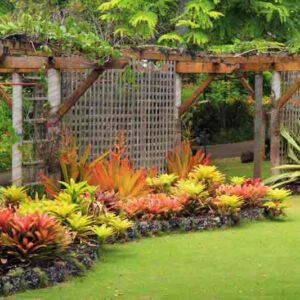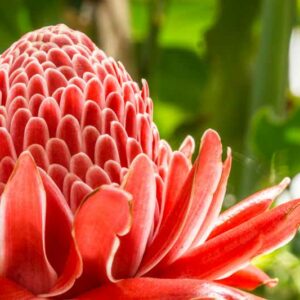Giant Bird of Paradise (Strelitzia nicolai), which is grown mostly for its beautiful leaves, adds a stunning tropical touch to a garden or a sunny room inside. This huge evergreen perennial grows in clumps of woody stems that can be straight or curved and can grow up to 30 feet (9 m) tall. The leaves are enormous, 5-10 ft. long (150-300 cm), oblong, shiny gray-green with long, thick leaf stalks. They resemble the leaves of banana plants and are arranged fanwise on the stems. They tear in the wind and come to resemble giant feathers. There are big blue and white flowers that bloom all year, but the best times are in the spring and summer. long (50 cm) are produced in succession from purplish-gray beak-like spathes. The beautiful flowers are bigger than those of Strelitzia reginae and have a white crest and a purple beak that look like the head of a bird. Since one flower spathe sprouts out of another, this gives them a double-decked appearance. The Giant Bird of Paradise is beautiful all year and is often grown as an ornamental because of its exotic flowers and lush, tropical leaves. A Giant Bird of Paradise can be a real showpiece in the landscape.
Learn how to grow lush, healthy, and spectacular Bird of Paradise plants outdoors or as houseplants.
With its uniquely shaped, vibrant blooms and huge, paddle-shaped leaves, the Giant Bird of Paradise plant is one of the most distinctive tropicals you can grow. Scientifically known as Strelitzia nicolai, this spectacular ornamental plant is sure to become a focal point wherever it’s situated.
In this care guide, you’ll learn all about successfully cultivating the Giant Bird of Paradise, both indoors and in the garden.
An Overview of Strelitzia nicolai
Native to South Africa, the Giant Bird of Paradise is a herbaceous perennial but may become treelike, growing up to 30 feet tall in tropical climates. Its botanical name honors the House of Mecklenburg-Strelitz from Germany.
This plant is known for its enormous gray-green leaves that can reach 10 feet long and its unique flowers that resemble a white bird in flight. The blossoms emerge from large purplish bracts.
Other common names for this plant include Wild Banana, Crane Flower, and White Bird of Paradise. It’s closely related to the Orange Bird of Paradise (Strelitzia reginae).
Growing Conditions for Giant Bird of Paradise
When situated in the right spot, the Giant Bird of Paradise is easy to maintain. Here are its key growing requirements:
- Sunlight: Full sun to partial shade
- Soil: Fertile, well-draining
- Temperature: Above 60°F
- Humidity: Average to high
- Hardiness Zones: 10-12
This tropical prefers consistent warmth and does not tolerate frost, It thrives in humid environments,
Caring for Giant Bird of Paradise Plants
With proper care your Giant Bird of Paradise will flourish for years to come. Follow these tips
-
Water frequently in spring and summer, allowing the soil to partially dry out between waterings. Reduce watering in winter but don’t let it completely dry out.
-
Fertilize monthly during the growing season with a balanced liquid fertilizer.
-
Prune off dead leaves and spent flowers to keep it neat and encourage new growth.
-
Repot every 2-3 years in spring, moving it to a slightly larger container.
-
Mist the leaves to boost humidity. Group plants to raise the moisture around them.
-
Watch for pests like scale, mealybugs, and red spider mites and treat any infestations promptly.
-
Bring potted plants indoors before temperatures drop below 60°F. Acclimate it to indoor conditions gradually.
How to Grow Giant Bird of Paradise from Seed
Giant Bird of Paradise can be propagated from seed. Here’s how:
-
Use fresh seeds collected from ripe seed pods.
-
Sow seeds in a sterilized starting mix, 1⁄4 inch deep.
-
Maintain a temperature around 70°F for best germination.
-
Keep the soil moist but not saturated.
-
Germination occurs within 3-8 weeks.
-
Transplant seedlings when they are 6-8 inches tall.
Tips for Pruning and Training Giant Bird of Paradise
To keep your Giant Bird of Paradise bushy and compact:
-
Pinch or cut back leggy shoots by half their length in early spring.
-
Remove spent flower stalks after blooming finishes.
-
Prune off lower leaves as needed for a tidy appearance.
-
Stake or trellis tall plants to provide support and prevent toppling.
Common Problems With Giant Bird of Paradise
Giant Bird of Paradise is not prone to many serious issues but may encounter:
-
Leaf spots – Caused by fungal disease. Improve airflow and avoid wetting foliage.
-
Mealybugs – Cottony insects that feed on plant sap. Wipe off with alcohol or insecticidal soap.
-
Bacterial wilt – Leaves yellow and wilt. Destroy infected plants; avoid overhead watering.
-
Leaf burn – Brown crispy edges from too much light or low humidity. Move to partial shade and mist frequently.
With proper siting and care, you can avoid most problems and enjoy the splendor of the Giant Bird of Paradise for many years. Its huge, architectural leaves and stunning blooms will make a bold, exotic statement in your tropical garden.
Alternative Plants to Consider


Find In One of Our Guides or Gardens



All About The Giant Bird’s Of Paradise / How to Care for Strelitzia Nicolai -White Birds Of Paradise
- The Ultimate Guide to Growing Strawberries in Raised Beds - August 8, 2025
- No-Dig Garden Beds: The Easiest Way to Grow a Beautiful Garden - August 6, 2025
- How to Protect and Preserve Wood for Raised Garden Beds - August 6, 2025

